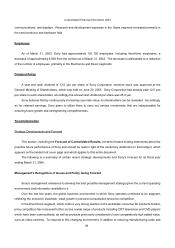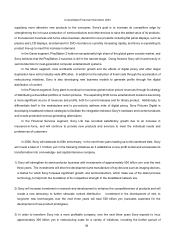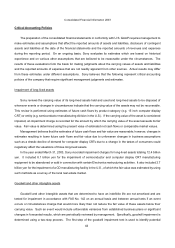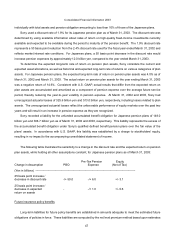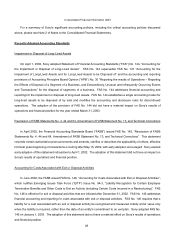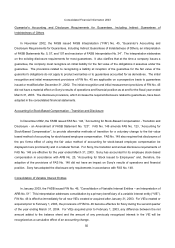Sony 2003 Annual Report Download - page 131
Download and view the complete annual report
Please find page 131 of the 2003 Sony annual report below. You can navigate through the pages in the report by either clicking on the pages listed below, or by using the keyword search tool below to find specific information within the annual report.
Consolidated Financial Information 2003
45
impairment by comparing the fair value of a reporting unit (generally, Sony’s operating segments) with its carrying
amount, including goodwill. If the fair value of a reporting unit exceeds its carrying amount, goodwill of the reporting
unit is considered not impaired and the second step of the impairment test is unnecessary. If the carrying amount of
a reporting unit exceeds its fair value, the second step of the goodwill impairment test is performed to measure the
amount of impairment loss, if any. The second step of the goodwill impairment test compares the implied fair value of
the reporting unit’s goodwill with the carrying amount of that goodwill. If the carrying amount of the reporting unit’s
goodwill exceeds the implied fair value of that goodwill, an impairment loss is recognized in an amount equal to that
excess. The implied fair value of goodwill is determined in the same manner as the amount of goodwill recognized in
a business combination. That is, the fair value of the reporting unit is allocated to all of the assets and liabilities of that
unit (including any unrecognized intangible assets) as if the reporting unit had been acquired in a business
combination and the fair value of the reporting unit was the purchase price paid to acquire the reporting unit. The
impairment test for other intangible assets consists of a comparison of the fair value of the intangible asset with its
carrying value. If the carrying value of the intangible asset exceeds its fair value, an impairment loss is recognized in
an amount equal to that excess.
Determining the fair value of a reporting unit under the first step of the goodwill impairment test and determining
the fair value of individual assets and liabilities of a reporting unit (including unrecognized intangible assets) under the
second step of the goodwill impairment test is judgmental in nature and often involves the use of significant estimates
and assumptions. Similarly, estimates and assumptions are used in determining the fair value of other intangible
assets. These estimates and assumptions could have a significant impact on whether or not an impairment charge is
recognized and also the magnitude of any such charge. In its impairment review, Sony performs internal valuation
analyses and considers other market information that is publicly available. Estimates of fair value are primarily
determined using discounted cash flows. This approach uses significant estimates and assumptions including
projected future cash flows, timing of such cash flows, discount rates reflecting the risk inherent in future cash flows,
perpetual growth rates, determination of appropriate market comparables and the determination of whether a
premium or discount should be applied to comparables. Since the adoption of FAS No. 142, Sony has performed
internal valuation analyses on an annual basis and no material impairment loss has been recognized. Management
believes that the estimates of future cash flows and fair value are reasonable; however, changes in estimates
resulting in lower future cash flows and fair value due to unforeseen changes in business assumptions could
negatively affect the valuations, which may result in Sony recognizing the impairment of goodwill and other intangible
assets in the future. As of March 31, 2003, a 10% decrease in the fair value of each of Sony’s reporting units would
not have resulted in a material impairment charge.
Investments
Sony’s investments are comprised of debt and equity securities accounted for under both the cost and equity
method of accounting. If it has been determined that an investment has sustained an other-than-temporary decline in
its value, the investment is written down to its fair value by a charge to earnings. Sony regularly evaluates its





